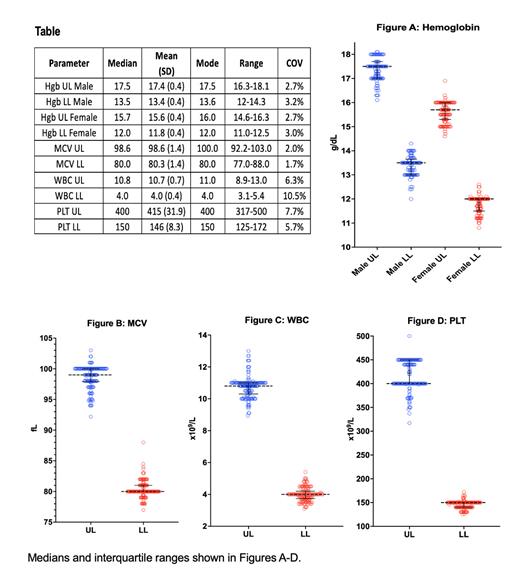Background
Complete blood count (CBC) is the most common hematology test performed. Reference limits, aka normal values, are known to vary from one hospital to another. However, little is known about the values of the upper (UL) and lower (LL) limits of common elements reported in the CBC and how they differ among facilities. The objectives of our study were to report the UL and LL of CBC elements from various hospitals in the US, analyze the variances, and describe their clinical significance.
Methods
This study was approved by the Mayo Clinic institutional review board. We obtained the reference limits of CBCs from various hospitals using the Epic electronic medical records Care Everywhere health information exchange. CBCs from 2020-2023 were included. We included the following CBC elements: hemoglobin (Hgb; male and female), mean cell volume (MCV), white blood cell count (WBC), and platelet count (PLT). We performed descriptive statistics and calculated the coefficients of variation (COVs). In addition, we analyzed the data for clinical context using: A) World Health Organization (WHO) major criterion for polycythemia vera of Hgb >16.5 g/dL and >16.0 g/dL for males and females, respectively; B) WHO major criterion for essential thrombocytosis of PLT >450 x109/L; and C) common textbook reference limits for MCV (80-100 fL) and WBC (5-10 x109/L).
Results
We collected CBC reference limits from 143 hospitals across 43 states and 99 cities. Most (54.5%) hospitals were community-based, while the rest (45.5%) were academic. The statistics are shown in the Table. In general, there was minimal variance in the UL and LL of CBC elements, with COVs mostly under 8.0%. The one exception was WBC LL, in which the COV was 10.5%. There was no significant difference in the CBC reference limits between academic and community hospitals. The median Hgb UL and LL for males were 17.5 (range, 16.3-18.1) and 13.5 (range, 12.0-14.3), respectively. Similarly, the median Hgb UL and LL for females were 15.7 g/dL (range, 14.6-16.3) and 12.0 g/dL (range, 11.0-12.5), respectively. Majority (93.5%) of the hospitals' male Hgb UL exceeded 16.5 g/dL. In contrast, only few (3.6%) of the hospitals' female Hgb UL exceeded 16.0 g/dL (Figure A). The median MCV UL and LL were 99.0 fL (range, 92.2-103.0) and 80.0 fL (range, 77.0-88.0), respectively. A substantial minority (19.6%) of the hospitals' MCV UL exceeded 100 fL (Figure B). The median WBC UL and LL were 10.8 x109/L (range, 8.9-13.0) and 4.0 x109/L (range, 3.1-5.4), respectively. Most (80.4%) hospitals' WBC UL exceeded 10 x109/L (Figure C). The median PLT UL and LL were 400 x109/L (range, 317-500) and 150 x109/L (range, 125-172), respectively. Over a quarter (27.5%) of the hospitals' PLT UL were at or exceeded 450 x109/L (Figure D).
Conclusions:
There was minimal variance in CBC reference limits across hospitals in the US with WBC LL having the highest COV. Most MCV UL and WBC UL exceeded common textbook reference limits. Almost all male Hgb UL and over a quarter of PLT UL exceed the WHO major criteria of polycythemia vera and essential thrombocytosis, respectively. Since our findings suggest that there could be a risk of underdiagnosing these myeloproliferative neoplasms due to the commonly used reference limits, clinical context must be used when interpreting normal CBC results, especially when there is a suspicion of polycythemia vera or essential thrombocytosis.
Disclosures
No relevant conflicts of interest to declare.


